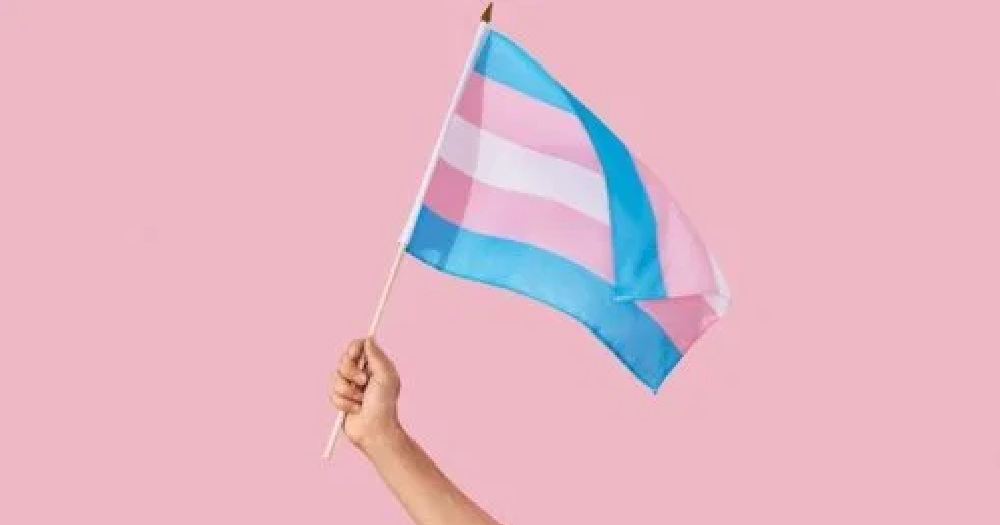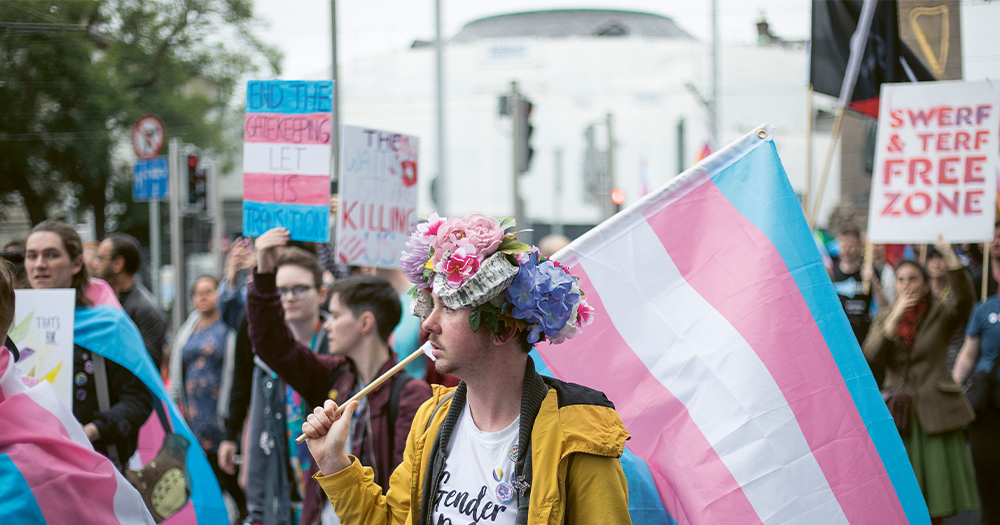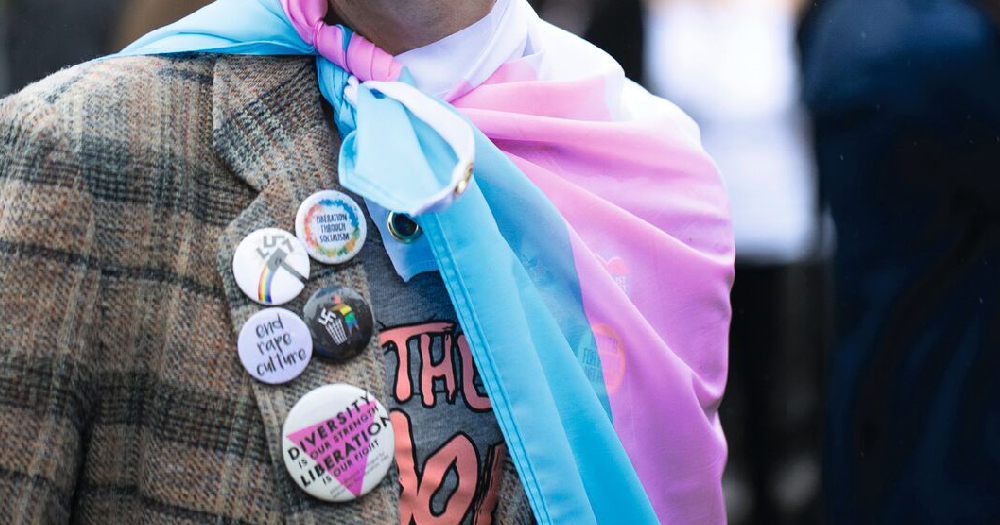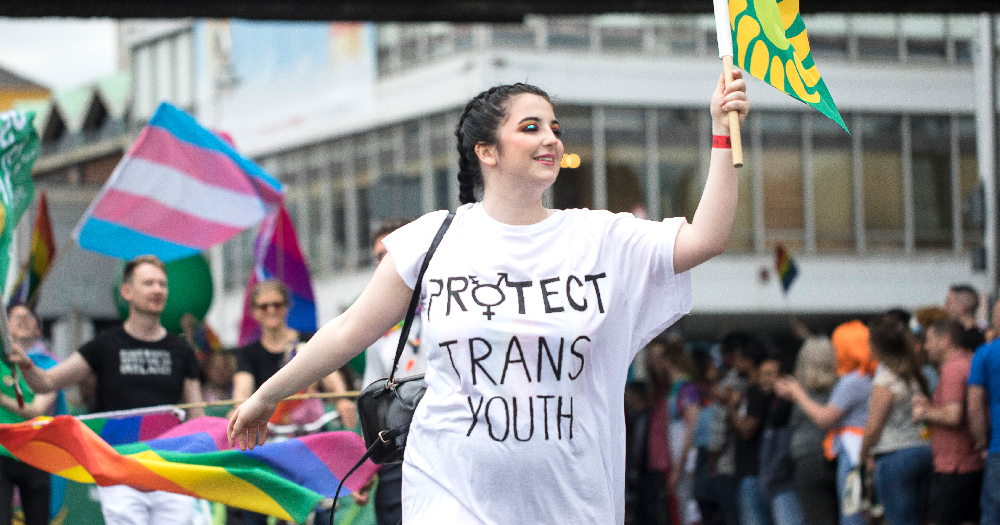CW: Transphobic inaccuracies and inflammatory statements
A note from GCN: Members of LGB Alliance Ireland recently co-authored a “right to respond” opinion piece published by The Independent both in print and online.
LGB Alliance Ireland was set up in late October and it has since been uncovered that the IP address for the group was located to London.
The dissemination of transphobic inaccuracies dressed as opinion in mainstream media with no fact-checking being undertaken obscures the truth leaving readers confused about what to trust. Discerning this, Siobhan Danette Thomas has fact-checked the claims made in LGB Alliance Ireland’s most recent Twitter thread.
LGB Alliance Ireland Claim 1
“Gender dysphoria in the DSM5 is defined as ‘a strong and persistent cross-gender identification (not merely a desire for any perceived cultural advantages of being the opposite sex.)” This conflates the condition with the treatment in a way that is unique to gender dysphoria’.”
Claim 1 Fact Check
The Diagnostic and Statistical Manual of Mental Disorders (DSM5) definition of gender dysphoria does not conflate the diagnostic criteria with treatment, to suggest so actually misunderstands the point of diagnostic criteria. The “strong and persistent cross-gender identification” is the diagnostic criteria, while transitioning would be the treatment. It implies a possible treatment, sure, but the treatment of a condition is always informed by the diagnosis and our current understanding of its aetiology. That is the clinical utility of diagnostic classifications and this is true of everything you will find in the DSM.
LGB Alliance Ireland Claim 2
“Dysphoria is from the Greek, dusphoros, meaning ‘hard to bear’. It refers to a state of unease or general dissatisfaction. It can refer to things other than gender/sex but is mostly used in this context.”
Claim 2 Fact Check
This is true but I would add a definition of gender dysphoria that provides a lot more context for how the concept is used: Gender dysphoria “is a clinical term used to describe the symptoms of excessive pain, agitation, restless, and malaise that gender-variant people seeking therapy often express” (1) (Lev, 2004, p.910). It’s important that we don’t use dysphoria as a synonym for transgender, otherwise, we get the misunderstanding that occurs in LGB Alliance Ireland’s thread.
LGB Alliance Ireland Claim 3
“Gender is a term coined by sexologist John Money in 1955, meaning ‘all those things a person says or does to disclose himself or herself as having the status of a boy or man, girl or woman’. This makes the idea of gender dysphoria seem a little… hokey.”
Claim 3 Fact Check
More context is really needed here. The term gender was introduced by John Money as a distinction from biological sex because Money believed that gender was socially constructed and that someone would identify with a gender if socialised that way from birth; i.e. that gender could be assigned. As his disastrous and unethical experiment with David Reimer demonstrated, this was not the case.
LGB Alliance Ireland Claim 4
“How can a person be dissatisfied with all the things they say and do that indicate whether they are male or female? In reality, this definition makes a mockery of what gender dysphoria is like to live with. Try a thought experiment.”
Claim 4 Fact Check
This comment presupposes that our current understanding of gender is the same as it was 65 years ago when Money introduced the term. However, our understanding of gender has developed a lot since this time. We have moved on from such definitions to acknowledge the complexity of gender identity (e.g. gender identity vs gender roles, social gender vs psychological gender), and to investigate where gender identity comes from. This research is new and emerging, but studies in this area suggest that gender identity (like most traits!) is a complex interaction of biological, psychological, and social processes (2) (Erickson-Schroth, 2013; Polderman et al., 2018). Not so hokey.

LGB Alliance Ireland Claim 5
“Imagine being a straight man and waking up tomorrow with two sore, useless, heavy balloons attached to your chest. Imagine that a good number of the men around you now leer unashamedly at these balloons, dismissing and sexualising you. Not all the men, but enough of them.”
Claim 5 Fact Check
This sounds fairly accurate; except I would stress that social dysphoria is not the only way in which trans people experience this distress. The physical, embodied reality of that situation is really important, as research suggests that body ownership (how much your body feels like your own) is important in explaining gender dysphoria (3) (Gliske, 2019).
LGB Alliance Ireland Claim 6
“You will never be ‘one of the lads’ again. That’s dysphoria. It is an intense and difficult to bear dissatisfaction with the sexed aspects of the body, and what those aspects mean for how you are treated by the people around you.
Claim 6 Fact Check
This describes dysphoria accurately but it’s important to emphasise that it’s not just a social process. Of massive importance is the embodied reality I just mentioned – i.e. how someone perceives their body regardless of others’ reactions to it.
LGB Alliance Ireland Claim 7
“Under those circumstances, you might want to go to the doctor to get the useless balloons removed, right? But that wouldn’t be part of the condition of dysphoria, that would be what you want to do about having two sore, useless balloons attached to your chest.”
Claim 7 Fact Check
As already stated, there is no conflation of the “condition” of gender dysphoria and the “treatment” of transitioning. That is a misunderstanding of how diagnostic criteria are used. The treatment here of removing the breast tissue is informed by the diagnosis, correct, but that doesn’t mean that the treatment is part of the diagnosis.
LGB Alliance Ireland Claim 8
“Likewise, a desire to transition cannot be part of the condition of dysphoria. That would be like saying that a desire to take Sertraline is part of depression. Medical transition is one of the ways to manage dysphoria, not a part of the condition itself.”
Claim 8 Fact Check
A desire to transition and gender dysphoria are not the same (and no one claims them to be!). Again, diagnosis and treatment are informed by one another but that doesn’t mean they are the same thing. A more accurate statement would be “Sertraline is used to treat depression because of what we know about the aetiology of condition.” Makes sense, right? This is correct that medical transition is one way to deal with dysphoria. It’s also considered best practice because of the evidence of its efficacy i.e. we know it works to help people manage their dysphoria (4) (Dhejne, Van Vlerken, Heylens & Arcelus, 2016), whereas no alternatives have been found to be effective (5) (Wright, Candy & King, 2018).
LGB Alliance Ireland Claim 9
“Dysphoria, like all the conditions in the DSM 5, comes in degrees. You might have a bit of dysphoria, and sometimes feel annoyed that you have periods, and wish you didn’t have a womb, or you might be so distressed by your sexed body that you attempt suicide.”
Claim 9 Fact Check
Of course, all emotional states exist on a spectrum, including discomfort with sexed characteristics. However, you do not meet the diagnostic criteria for a condition in the DSM if it is not marked, persistent, and if it does not negatively affect your wellbeing. What this means for dysphoria, is that you cannot be diagnosed with “a bit of dysphoria”. Remember from the first point – it needs to be “strong and persistent cross-gender identification” to meet the criteria for diagnosis. Similarly, to how you wouldn’t be diagnosed with depression if you felt a bit low one day, you wouldn’t be diagnosed with gender dysphoria if you sometimes were annoyed with your period.

LGB Alliance Ireland Claim 10
“Many lesbians and gay men grow up with some level of dysphoria. What could be more natural than a tomboyish little girl wishing that she were a boy, so she could marry her best female friend, and hating her female body that disqualifies her from that?”
Claim 10 Fact Check
It’s true that some gay people experience dysphoria. I myself do and I’m a cis woman. However, my own feelings of dysphoria come from sexual identity and trauma, and these feelings should not be conflated with the dysphoria experienced by trans people. Remember – dysphoria isn’t a synonym for being trans, it’s just “a clinical term used to describe the symptoms” often experienced by trans people.
Different people can experience the same psychological symptoms for entirely different reasons. It’s true that some gay young people may have some thoughts about gender exploration as a result of sexual identity or trauma. However, young people are not being coerced into medically transitioning by anyone and need to be given the space to explore whether they are trans or whether they are gay (or both!).
The way to tackle fears that non-trans young people are going to transition is through the reduction of the stigma of gender-nonconformity and queer identities, not by stigmatising trans identities. We will not help either trans people or non-trans dysphoric people by blanket banning any young people from exploring their gender.
LGB Alliance Ireland Claim 11
“Twenty years ago, those tomboyish little girls grew up and sought out the LGB community, where they quickly learned that butch lesbians not only existed, but were highly respected by everybody, and wildly popular with lesbian and bisexual women of all kinds.”
Claim 11 Fact Check
There is overlap between butch and transmasculine experiences, but we cannot conflate butch women with trans men. The dysphoria of a trans man is not the same as that of a butch lesbian and to claim it is, denies how people experience their own body and gender. Remember – same symptoms, different reasons. To understand trans experiences better, we really need to move away from this excessive focus on dysphoria and look at how people experience their gender – i.e. gender identity.
LGB Alliance Ireland Claim 12
“That community no longer exists, in that form, to welcome these young women. Instead, they are told that dysphoria will lead them to kill themselves unless they transition. Instead of a warm community, they are met by doctors with drugs and scalpels.”
Claim 12 Fact Check
This is blatantly untrue and presented in a very charged way. Butches still exist, they still welcome baby butches to the community, and butches are still respected in the LGBTQ+ community. Discovering that I could find comfort in butchness was a huge source of relief to me in my late 20s. Butches are not told that they are trans by the community, instead, I would argue that people are given the space and respect to figure out who they are. Supporting trans men who originally believed themselves to be butch women does not mean that all butches are told they are men. It’s a bit of a logical fallacy to suggest so.
LGB Alliance Ireland Claim 13
“They are met by an LGBT community with an entry requirement; you must accept gender ideology, same gender, not same sex attraction, or you will be vilified, called hateful, transphobic, a terf. If you are dysphoric, you aren’t a lesbian or a gay man, you are an ‘egg’.”
Claim 13 Fact Check
No, blatantly untrue. The “egg” they are referring to is a term trans people use to refer to themselves at an earlier time before they figured out their gender identity. Of course, you are not trans just because you experience the smallest bit of dysphoria, this is not a common opinion among trans activists despite claims otherwise.
This conflation seems to come instead from gender critical people themselves and ignores how important gender identity is. People in the LGBTQ+ community are supportive of gender-nonconforming people who ask questions about their gender, however, this doesn’t equate to people being told they are trans because they are gender-nonconforming. Again, this is a logical fallacy. Gender nonconformity can exist in cis people and is respected and embraced in the community too.
LGB Alliance Ireland Claim 14
“An egg to be ‘hatched’, persuaded that medical transition is the best way to deal with your dysphoria. But there are other treatments. With children, the best may be ‘watchful waiting’. 80% of dysphoric children simply grow out of it, most becoming lesbian or gay adults.”
Claim 14 Fact Check
“Watchful waiting” is only watchful if we know when to intervene and stop hoping that the distress will subside on its own. The number of people who “grow out of it” is actually not known; this statistic of 80% is not accurate for a number of reasons (6) (Newhook et al., 2018). The consistent emphasis on “80%” desistance doesn’t reflect the wider body of research. Julia Serano details the reasons for this far more eloquently than me here.

LGB Alliance Ireland Claim 15
“Talking therapies can also be very helpful, particularly CBT. CBT is very effective for OCD. The intrusive and troubling thoughts in dysphoria have similar features to those of OCD, can also be challenged by CBT techniques. You can learn to love the skin you’re in”
Claim 15 Fact Check
CBT is very effective for OCD. However, these are entirely different psychological concepts and the same cannot be same for its effectiveness in dealing with dysphoria. There is no research which would suggest that CBT is an effective treatment for dysphoria. There is research which shows that CBT is useful for treating conditions that co-occur with dysphoria (anxiety, OCD, depression), but this does not mean that CBT treats the dysphoria itself. Learning to love the skin you’re in when you experience dysphoria depends massively on the reasons for that dysphoria.
LGB Alliance Ireland Claim 16
“Some lesbians manage their dysphoria through butch/femme dynamics. Some lesbians move to women’s land. This frees them from the male gaze, which can remove the social aspect of dysphoria almost completely. And some people manage their dysphoria with drugs and surgeries.”
Claim 16 Fact Check
Again, this conflates butch lesbians with trans masculine people, conflates experiencing dysphoria with being trans, and conflates the dysphoria of sexual identity with the dysphoria of gender identity. None of this is accurate and therefore we can’t compare what lesbians do with what trans people do.
LGB Alliance Ireland Claim 17
“We support their right to do so, as adults. The seriousness of these interventions, however, requires a high level of medical gatekeeping. Women seeking hysterectomies for any other reason than transition will find it very difficult to access one, for good reason.”
Claim 17 Fact Check
There is a very high level of medical gatekeeping. Extremely high. I cannot state this enough. Ireland uses a medical model that is exhausting, protracted and complex for the people who navigate it. It is not easy to get gender-affirming treatment in this country and all empirical research in this area agrees with this statement (7) (Collins & Sheehan, 2004; McNeil et al., 2013) I’ve conducted research in this area myself.
LGB Alliance Ireland Claim 18
“So why is it so easy for trans identified people to get access to potentially sterilising treatment? Treatment that may remove the ability to experience sexual pleasure? Treatment that will drastically alter their physical appearance, and narrow their dating choices?”
Claim 18 Fact Check
As above, it’s not easy. This also focuses a lot on what this person believes to be negative consequences of medically transitioning. However, we actually know from the research literature that transitioning is actually massively beneficial to trans people; benefits reported in the literature include congruency of self and increased resilience (8) (Riggle et al., 2001), lower depression and anxiety symptomology (9) (Budge, Adelson & Howard, 2013; (10) Gomez-Gil et al., 2012) and better overall psychological functioning (11) (Strain & Shuff, 2010).
LGB Alliance Ireland Claim 19
“It can’t be because they will kill themselves otherwise. If it were true that folk with dysphoria would kill themselves if not affirmed and given access to drugs and surgeries, what happened before the 1950s, or in countries where drugs and surgeries are not available?”
Claim 19 Fact Check
Not folk with dysphoria, trans people. Trans people are more than their dysphoria and conflating them with cis people who experience minor dysphoria due to other reasons is not useful. It’s difficult to know what happened before the 1950s because trans people are often erased through the way we tell history. We know that trans people existed back then but know little of their lived experiences.

LGB Alliance Ireland Claim 20
“And what other area of medicine do doctors respond to ‘I will kill myself if you don’t give me my preferred treatment option’ with ‘your suicidality has persuaded me that you are correct about the treatment that you need’. This approach encourages suicide threats/attempts.”
Claim 20 Fact Check
This is hardly an accurate representation of how interactions between health professionals and trans people unfold. In actuality, in all areas of medicine, a patient’s mental health is considered in the treatment that they are given. This is especially the case in issues of bodily autonomy because health includes both physical and mental health. This was the case with abortion access in Ireland before the referendum, for example.
Taking a patient’s suicidality seriously and considering it as an important factor in their healthcare does not mean encouraging suicide threats or attempts.
LGB Alliance Ireland Claim 21
“We seek to normalise and reclaim dysphoria, and to open a conversation about what it is like to experience it, and treatment options. We reject the absurd notion that everybody with dysphoria must transition or commit suicide. We stand in solidarity with dysphoric people.”
Claim 21 Fact Check
Dysphoria is not something to reclaim (who are you reclaiming it from?), it’s a clinical term used for many different people. Everyone should have access to treatment that helps manage their gender dysphoria, and that treatment will obviously differ substantially between people. Openness about gender dysphoria does not mean rejecting the validity of trans people. Rather than call for a repeal of trans rights, effort would be better spent on breaking down the stigma of gender-nonconformity, and gay and trans identities.
References
- Lev, A. I. (2004). Transgender Emergence: Therapeutic Guidelines for Working with Gender-Variant People and their Families. New York, NY: Haworth Clinical Practice Press.
- Erickson-Schroth, L. (2013). Update on the Biology of Transgender Identity, Journal of Gay & Lesbian Mental Health, 17:2, 150-174,
- Gliske, S.V. (2019). A New Theory of Gender Dysphoria Incorporating the Distress, Social Behavioral, and Body-Ownership Networks, eNeuro, 6:6, DOI: https://doi.org/10.1523/ENEURO.0183-19.2019.
- Dhejne, C., Van Vlerken, R., Heylens, G., & Arcelus, J. (2016). Mental health and gender dysphoria: A review of the literature. International Review of Psychiatry, 28(1), 44–57.
- Wright, T., Candy, B., King, M. (2018). Conversion therapies and access to transition-related healthcare in transgender people: a narrative systematic review, BMJ Open, 8:022425. DOI: 10.1136/bmjopen-2018-022425.
- Newhook, J.T., Pyne, J., Winters, K., Feder, S., Holmes, C., Tosh, J., Sinnott, M., Jamieson, A. & Pickett, S. (2018). A critical commentary on follow-up studies and “desistance” theories about transgender and gender-nonconforming children, International Journal of Transgenderism, 19:2, 212-224.
- Collins, E. & Sheehan, B. (2004). Access to Health Services for Transsexual People. The Equality Authority. http://lenus.ie/hse/handle/10147/44869.
- Riggle, E. D. B., Rostosky, S. S., McCants, L. E., & Pascale-Hague, D. (2011). The positive aspects of a transgender self-identification. Psychology and Sexuality, 2(2), 147–158.
- Budge, S. L., Adelson, J. L., & Howard, K. S. (2013). Anxiety and depression in transgender individuals: The roles of transition status, loss, social support, and coping. Journal of Consulting And Clinical Psychology, 81(3), 545-557.
- Gómez-Gil, E., Zubiaurre-Elorza, L., Esteva, I., Guillamon, A., Godás, T., Cruz Almaraz, M., Halperin, I., Salamero, M. (2012). Hormone-treated transsexuals report less social distress, anxiety and depression. Psychoneuroendocrinology, 37:5, 662-70.
- Strain, J. D., & Shuff, I. M. (2010). Psychological well-being and level of outness in a population of male-to-female transsexual women attending a national transgender conference. International Journal of Transgenderism, 12:4, 230-240.
There are numerous supports available to LGBTQ+ people, listed below, and many offer instant messaging support if you want to seek advice.
© 2020 GCN (Gay Community News). All rights reserved.
Support GCN
GCN is a free, vital resource for Ireland’s LGBTQ+ community since 1988.
GCN is a trading name of National LGBT Federation CLG, a registered charity - Charity Number: 20034580.
GCN relies on the generous support of the community and allies to sustain the crucial work that we do. Producing GCN is costly, and, in an industry which has been hugely impacted by rising costs, we need your support to help sustain and grow this vital resource.
Supporting GCN for as little as €1.99 per month will help us continue our work as Ireland’s free, independent LGBTQ+ media.
